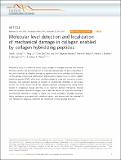| dc.contributor.author | Zitnay, Jared L. | |
| dc.contributor.author | Li, Yang | |
| dc.contributor.author | San, Boi Hoa | |
| dc.contributor.author | Reese, Shawn P. | |
| dc.contributor.author | Yu, S. Michael | |
| dc.contributor.author | Weiss, Jeffrey A. | |
| dc.contributor.author | Qin, Zhao | |
| dc.contributor.author | Depalle, Baptiste Pierre Jean | |
| dc.contributor.author | Buehler, Markus J | |
| dc.date.accessioned | 2017-06-20T20:00:08Z | |
| dc.date.available | 2017-06-20T20:00:08Z | |
| dc.date.issued | 2017-03 | |
| dc.date.submitted | 2015-11 | |
| dc.identifier.issn | 2041-1723 | |
| dc.identifier.uri | http://hdl.handle.net/1721.1/110088 | |
| dc.description.abstract | Mechanical injury to connective tissue causes changes in collagen structure and material behaviour, but the role and mechanisms of molecular damage have not been established. In the case of mechanical subfailure damage, no apparent macroscale damage can be detected,
yet this damage initiates and potentiates in pathological processes. Here, we utilize collagen hybridizing peptide (CHP), which binds unfolded collagen by triple helix formation, to detect molecular level subfailure damage to collagen in mechanically stretched rat tail tendon
fascicle. Our results directly reveal that collagen triple helix unfolding occurs during tensile loading of collagenous tissues and thus is an important damage mechanism. Steered molecular dynamics simulations suggest that a likely mechanism for triple helix unfolding is
intermolecular shearing of collagen a-chains. Our results elucidate a probable molecular failure mechanism associated with subfailure injuries, and demonstrate the potential of CHP targeting for diagnosis, treatment and monitoring of tissue disease and injury. | en_US |
| dc.description.sponsorship | United States. Office of Naval Research. Presidential Early Career Award for Scientists and Engineers (N000141010562) | en_US |
| dc.description.sponsorship | United States. Air Force. Office of Scientific Research (FA95501110199) | en_US |
| dc.description.sponsorship | National Institutes of Health (U.S.) (TUFTS-5U01EB014976) | en_US |
| dc.description.sponsorship | National Institutes of Health (U.S.) (WUSTL- 5U01EB016422) | en_US |
| dc.description.sponsorship | Wellcome Trust (Grant WT097347MA) | en_US |
| dc.language.iso | en_US | |
| dc.publisher | Nature Publishing Group | en_US |
| dc.relation.isversionof | http://dx.doi.org/10.1038/ncomms14913 | en_US |
| dc.rights | Creative Commons Attribution 4.0 International License | en_US |
| dc.rights.uri | http://creativecommons.org/licenses/by/4.0/ | en_US |
| dc.source | Nature | en_US |
| dc.title | Molecular level detection and localization of mechanical damage in collagen enabled by collagen hybridizing peptides | en_US |
| dc.type | Article | en_US |
| dc.identifier.citation | Zitnay, Jared L. et al. “Molecular Level Detection and Localization of Mechanical Damage in Collagen Enabled by Collagen Hybridizing Peptides.” Nature Communications 8 (2017): 14913. | en_US |
| dc.contributor.department | Massachusetts Institute of Technology. Department of Civil and Environmental Engineering | en_US |
| dc.contributor.mitauthor | Qin, Zhao | |
| dc.contributor.mitauthor | Depalle, Baptiste Pierre Jean | |
| dc.contributor.mitauthor | Buehler, Markus J | |
| dc.relation.journal | Nature Communications | en_US |
| dc.eprint.version | Final published version | en_US |
| dc.type.uri | http://purl.org/eprint/type/JournalArticle | en_US |
| eprint.status | http://purl.org/eprint/status/PeerReviewed | en_US |
| dspace.orderedauthors | Zitnay, Jared L.; Li, Yang; Qin, Zhao; San, Boi Hoa; Depalle, Baptiste; Reese, Shawn P.; Buehler, Markus J.; Yu, S. Michael; Weiss, Jeffrey A. | en_US |
| dspace.embargo.terms | N | en_US |
| dc.identifier.orcid | https://orcid.org/0000-0002-4173-9659 | |
| mit.license | PUBLISHER_CC | en_US |
